Basic Scuba Hand Signals (Illustrated Guide)
Unless you dive with a full-face mask equipped with a voice communication system, and your dive buddy does too, it can be a challenge to communicate underwater.
One method is to use an erasable slate to convey messages, but an easier and therefore much more useful method is to use scuba diving hand signals.
You may remember from your certification course, or will learn soon that scuba hand signals are the primary means of communicating underwater. With a good knowledge of basic scuba hand signals, you can minimize confusion, keep diving safe, and convey anything you need to your dive buddy.
But, of course, in order for this to work, everybody has to be on the same page, signal-wise. While some dive buddy teams make up their own scuba diving hand signal that can work pretty well, the following are the most common scuba diving hand signals used by most divers to communicate while at depth.
Underwater Scuba Hand Signals
When using scuba diver hand signals under water it is good practice to respond to any diving signals directed at you with an "OK." This lets the signaling diver know his or her hand signal has been seen and understood.
It also shows that you are alert and paying attention which is an indication that you’re doing okay. Not responding doesn’t just create confusion, it can also be an indication that there is something wrong.
Having some sort of noise-maker like a tank banger, rattle stick or pneumatic horn can be handy tools for getting a buddy’s attention, because if he isn’t looking at you, it’s hard to make a successful hand signal.
"OK"

This is the first scuba hand signal divers learn. The “ok” signal can be used as both a question and an answer, and it’s also the proper response to any hand signal directed your way to acknowledge that it has been seen and understood.
This is the same hand signal you’d use on shore, i.e. make a circle with thumb and forefinger while raising your other three fingers.
"I’ve Got a Problem"
This signal indicates that all is not okay.
Used initially to get your partner's attention, it is quickly followed by another signal indicating either what the actual problem is or to point to the source of the problem.
To communicate underwater with this scuba diving hand signal, put your hand out in front of you and give it a wobble. A typical scenario would be to face your dive buddy, wobble your hand, and then, for example, point to your ear to indicate you’re having trouble equalizing.
Or, a hand wobble followed by pointing to a piece of gear indicates that it is not functioning properly or is otherwise creating some sort of problem.
"Going Up"
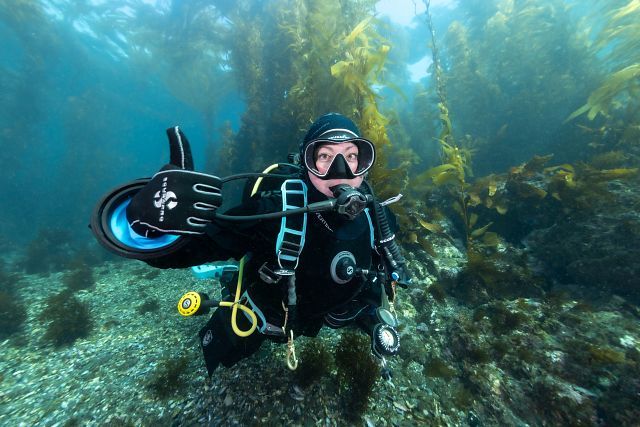
This is a simple thumbs-up signal telling your buddy that you’re going to ascend.
This can be used when you’re getting close to zeroing out your NDLs and need to ascend to a safer depth, or it could mean you’re ending your dive and heading to the surface. For this reason, the thumbs-up hand signal is often preceded or followed by another signal; e.g., a thumbs-up followed by a signal to level off at a shallower depth, or a low-on-air signal followed by a thumbs-up, meaning you’re heading to the surface.
"Going Down"
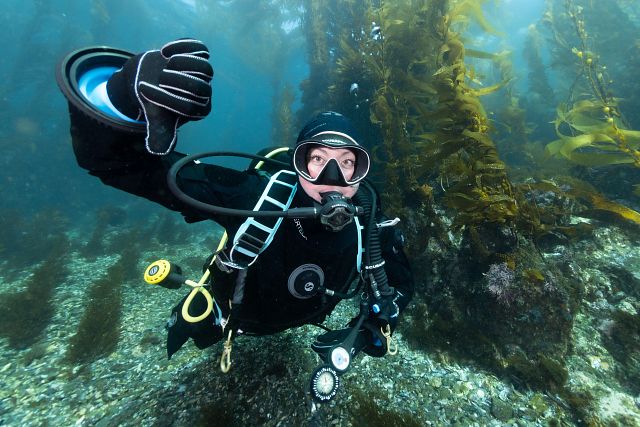
This signal is a simple reversal of the thumbs-up.
This is used mostly on or near the surface. After safely entering the water and stabilizing yourself, a thumbs-down signal tells your buddy you’re ready to start your descent. Or, when at depth this can be used to indicate your desire to go deeper, which would then be answered by an "OK" if your dive buddy is in agreement.
"Check it Out"

Often you see something really cool and you want to share it with your dive buddy.
With your two fingers, point at your own mask indicating that your dive buddy should "Look," followed by pointing at the animal or site you want him or her to check out.
"Follow Me"
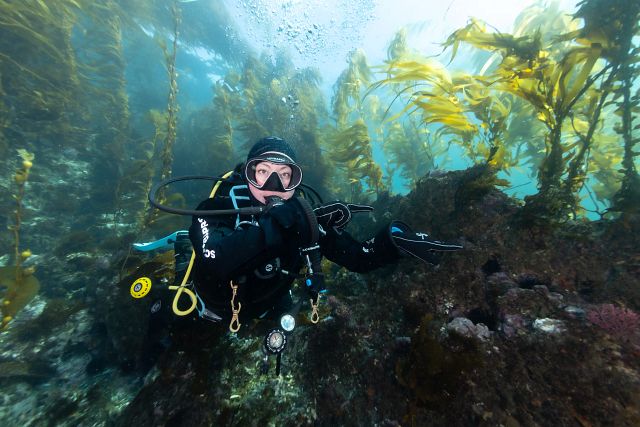
Once you decide on a direction, somebody has to take the lead.
If it’s going to be you, the way to signal this is to first point at yourself with an index finger, and then with your other index finger point to your buddy, positioning that finger just behind the first in the direction of travel.
If you want your buddy to take the lead, point to him or her first and then point at yourself, indicating you will follow.
"Slow Down!"
If you want your buddy to slow down, face them and hold one or both hands out in front of you, palms-down, then slowly press down like you’re trying to close an overfilled suitcase.
This will encourage your dive buddy to stay back with you and enjoy the scenery.
"Stop/Hold"
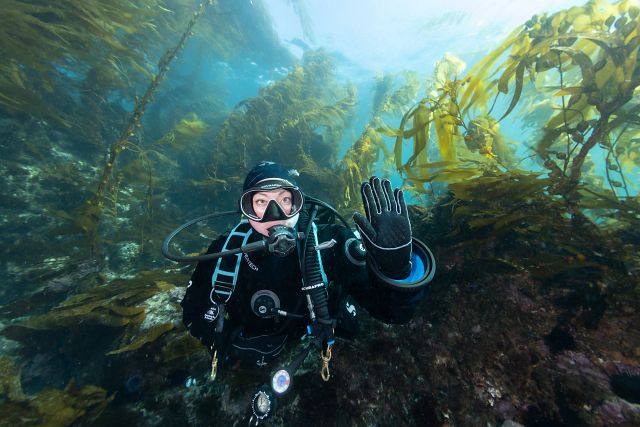
There are a couple common scuba hand signals to communicate “stop/hold”.
One is holding a flat hand up with palm forward, again like a traffic cop.
The other is to make a fist and hold it up, palm facing forward.
"Let’s Level Off"
During either an ascent or descent, if you want to level off at a certain depth, extend your open hand, palm-down, and move it from side to side, horizontally slicing through the water.
This will tell your buddy you want to maintain this depth for the time being.
"I’m Cold!"
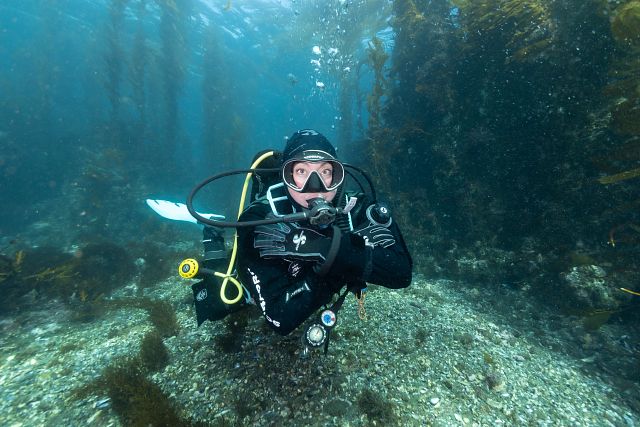
It’s no fun to stay on a scuba dive when you’re chilled to the bone.
To let your dive partner know you’re cold and need to end your dive, simply do what you’d do on the surface when cold – cross your arms over your body and rub your upper arms with your hands, as if trying to warm yourself.
"Time to Turn Around"
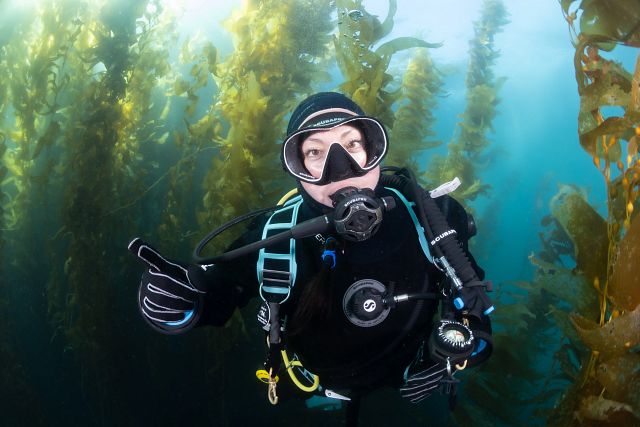
When you or your buddy reach the halfway mark on your pressure gauges and it is time to start heading back to the boat, simply put your index finger up and make a circular motion.
"Abort Dive or Danger is Near"
If a situation arises and you feel you’re approaching something dangerous, or something dangerous is approaching you, the first move is to close your fists and cross your arms over your chest.
This indicates that danger is present. The second move would be to either extend an arm with a closed fist in the direction of the danger, or to give a thumbs-up sign to abort the dive.
"Low on Air"
Everybody breathes down their air supply at different rates and how much air you have left may be different than your fellow divers.
To signal to your diving buddy how much air you have and that you’re low on air, make a fist and bring it to your chest. This is usually followed by a thumbs-up signal to head for the surface.
"Out of Air"
As opposed to "low on air" which is not meant as an emergency signal, "out of air" is a serious signal you can transmit to your dive buddy.
The "out of air" hand signal indicates its seriousness – it’s a knife-like open-hand slashing motion across your neck, which your dive buddy would respond to by swimming toward you in preparation of sharing air.
"Let’s Share Air"
To indicate you need to share air, take your open hand, palm towards you, and repeatedly bring it to your mouth, then toward your dive buddy’s mouth, sort of like blowing an underwater kiss.
This should prompt your dive buddy to approach with his octopus reg or alternate air source, ready to share air as you both make your way safely to the surface.
"Safety Stop"
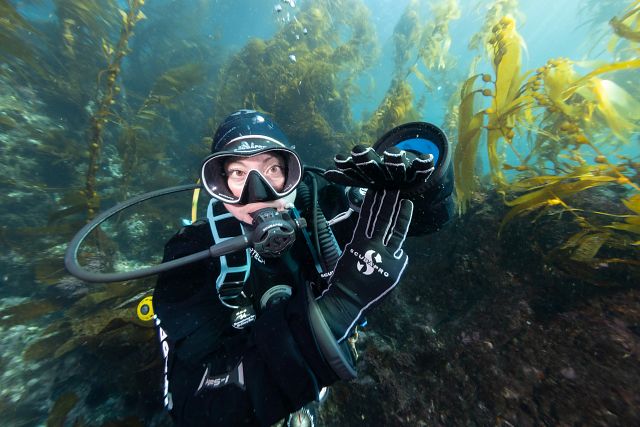
While a buddy team’s safety stop protocol is usually agreed upon before hitting the water, sometimes things change, and sometimes you forget, so a safety stop signal can be a welcome reminder.
To make the "safety stop" signal, when you reach a safety stop depth of 15 to 20 feet, hold out one flat hand horizontally – a la "level off" – and just under it extend three to five fingers vertically. The fingers indicate how many minutes you plan on spending at your safety stop.
On the Surface Scuba Hand Signals
Divemasters on dive boats are constantly on watch for divers in trouble. So as soon as your head breaks the surface, there will probably be a divemaster watching to see if you’re okay or if you need assistance.
Letting them know your status as soon as possible allows the divemaster to stop worrying about you and focus on other divers.
"I’m Okay"
There are two ways to signal to the dive boat that you’ve surfaced safely and are okay.
One is to grasp both hands together – or touch fingertips together – and hold them high over your head in a sort of "O" shape.
If both hands aren’t free to make this signal, then simply take one hand and touch the top of your head with your fingertips while holding your arm aloft, again in a sort of "O" shape.
"I Need Help"
If you reach the surface and you have a problem, the "I need help" signal is to wave your arm or arms high over your head as if waving "hi".
Seeing a diver in the water waving his arms like this will kick the divemaster into immediate rescue mode.
This is why you should never give a friendly wave to a passing boat while floating on the surface; if you do, they will likely assume you’re in trouble and react accordingly, which can be embarrassing if you just meant to say hello.
Using Scuba Hand Signals at Night
Scuba hand signals can also be very effective during night dives if you can illuminate your signals with a good dive light.
In such a case, if you want to communicate with your dive buddy, first get their attention by shining your dive light close to her, then giving it a shake so the light beam bounces within their field of vision.
This will get your buddy’s attention; they will then either shine their dive light on your chest area, at which time you can make your hand signal.
If you have their attention, but they don't put their light on you, then shine your own light on your chest and make the signal.
Then direct your light near your dive partner and wait for an 'OK signal' response.
Never shine a light directly into a diver’s eyes as this will destroy their night vision and may ruin the balance of their night dive.
With a bit of practice, you and your dive buddy can get so good at using scuba hand signals that communicating under water will become second nature. A number of organizations offer waterproof cards illustrating the most common scuba hand signals that you can keep in your dive bag for easy reference (e.g. PADI hand signals).
Stop by your favorite dive store and pick one up, and then grab your buddy and go diving.





